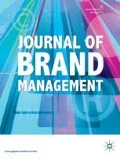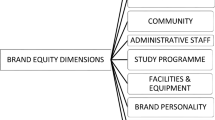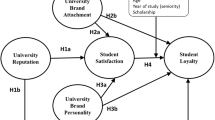Abstract
University brand (UniBrand) is a recent concept, and its theoretical modelling is still somewhat inadequate. This paper examines how perceived service quality affects UniBrand performance, UniBrand image and behavioural intention. Using an online student survey, the present study obtained 528 usable responses. The conceptual model was validated using structural equation modelling. The study makes an innovative theoretical contribution by establishing a relationship between experience-centric brand performance and brand image, and the antecedents and consequences of this link. In addition, student satisfaction and trust were demonstrated to mediate the relationship between perceived service quality, brand performance, brand image and behavioural intention in a higher education context. However, there were no moderating effects of gender or mode-of-study on the model, confirming that the model is invariant across these variables. Overall, this model suggests the importance of experience-centric service quality attributes and how they affect university branding strategies for sustained positive intentions.



Similar content being viewed by others
References
Abdullah, F. 2006. The development of HEdPERF: A new measuring instrument of service quality for the higher education sector. International Journal of Consumer Studies 30 (6): 569–581.
Akhoondnejad, A. 2018. Loyalty formation process of tourists in sporting event: The case of Turkmen horse races. Journal of Hospitality and Tourism Management 34 (March): 48–57.
Alves, H., and M. Raposo. 2007. Conceptual model of student satisfaction in higher education. Total Quality Management 18 (5): 571–588.
Alwi, S.F.S., and P.J. Kitchen. 2014. Projecting corporate brand image and behavioral response in business schools: Cognitive or affective brand attributes? Journal of Business Research 67 (11): 2324–2336.
Andreassen, T., and B. Lindestad. 1998. The impact of corporate image on quality, customer satisfaction, and loyalty for customers with varying degrees of service expertise. International Journal of Service Industry Management 9 (1): 7–23.
Anees-ur-Rehman, M., H.Y. Wong, P. Sultan, and B. Merrilees. 2018. How brand-oriented strategy affects the financial performance of B2B SMEs. Journal of Business and Industrial Marketing 33 (3): 303–315.
Berry, L.L. 2002. Relationship marketing of services—Perspectives from 1983 and 2000. Journal of Relationship Marketing 1 (1): 59–77.
Bradley, D., P. Noonan, H. Nugent, and B. Scales. 2008. Review of Australian higher education. Canberra: Department of Education, Employment and Workplace Relations.
Brown, R., and T. Mazzarol. 2009. The importance of institutional image to student satisfaction and loyalty within higher education. Higher Education 58 (1): 81–95.
Cassel, C., and J.A. Eklöf. 2001. Modelling consumer satisfaction and loyalty on aggregate levels: Experience from the ECSI pilot study. Total Quality Management 12 (7&8): 834–841.
Chapleo, C. 2010. Branding a university: Adding real value or smoke and mirrors. In The marketisation of higher education and student as consumer, ed. M. Molesworth, R. Scullion, and E. Nixon, 101–114. London: Routledge.
Chapleo, C. 2011. Exploring rationales for branding a university: Should we be seeking to measure branding in UK universities. Journal of Brand Management 18 (6): 411–422.
Chaudhuri, A., and M.B. Holbrook. 2001. The chain of effects from brand trust and brand affect to brand performance: The role of brand loyalty. Journal of Marketing 65 (2): 81–93.
Chenet, P., C. Tynan, and A. Money. 1999. Service performance gap: Re-evaluation and redevelopment. Journal of Business Research 46 (2): 133–147.
Cronin, J., and S. Taylor. 1992. Measuring service quality: A re-examination and extension. Journal of Marketing 56 (3): 55–68.
Cronin, J., and S. Taylor. 1994. SERVPERF versus SERVQUAL: Reconciling performance-based and perceptions-minus-expectations measurement of service quality. Journal of Marketing 58 (1): 125–131.
Cronin, J., M. Brady, and G. Hult. 2000. Assessing the effect of quality, value, and customer satisfaction on consumer behavioral intentions in service environments. Journal of Retailing 76 (2): 193–218.
De Chernatony, L., and G. McWilliam. 1990. Appreciating brands as assets through using a two-dimensional model. International Journal of Advertising 9 (2): 111–119.
Delgado-Ballester, E., and J.L. Munuera-Aleman. 2001. Brand trust in the context of consumer loyalty. European Journal of Marketing 35 (11&12): 1238–1258.
Deutskens, E., K. De Ruyter, M. Wetzels, and P. Oosterveld. 2004. Response rate and response quality of internet-based surveys: An experimental study. Marketing Letters 15 (1): 21–36.
Drori, G.S., G. Delmestri, and A. Oberg. 2013. Branding the university: Relational strategy of identity construction in a competitive field. In Trust in higher education, ed. L. Engwall and P. Scott, 134–147. London: Portland Press.
Duggal, E., and H.V. Verma. 2013. Service quality: Construct comprehension and evolution over time. Journal of Services Research 13 (1): 135–160.
Dunes, M., and B. Pras. 2017. The impact of the brand management system on performance across service and product-oriented activities. Journal of Product & Brand Management 26 (3): 294–311.
ECSI. 1998. European customer satisfaction index: Foundation and structure for harmonized national pilot projects. Stockholm: ECSI Technical Committee.
Fishbein, M. 1967. Readings in attitude theory and measurement. New York: Wiley.
Foroudi, P., K. Dinnie, P.J. Kitchen, T.C. Melewar, and M.M. Foroudi. 2017. IMC antecedents and the consequences of planned brand identity in higher education. European Journal of Marketing 51 (3): 528–550.
Ganesh, G., A. Paswan, and Q. Sun. 2015. Are face-to-face classes more effective than online classes? An empirical examination. Marketing Education Review 25 (2): 67–81.
Garbarino, E., and M.S. Johnson. 1999. The different roles of satisfaction, trust, and commitment in customer relationships. The Journal of Marketing 63 (2): 70–87.
Hair, J.F., W.C. Black, B.J. Babin, and R.E. Anderson. 2010. Multivariate data analysis: A global perspective. New York: Pearson Prentice Hall.
Han, H., Y. Kim, and E.K. Kim. 2011. Cognitive, affective, conative, and action loyalty: Testing the impact of inertia. International Journal of Hospitality Management 30 (4): 1008–1019.
Han, H., B. Meng, and W. Kim. 2017. Bike-traveling as a growing phenomenon: Role of attributes, value, satisfaction, desire, and gender in developing loyalty. Tourism Management 59: 91–103.
Harris, F., and L. de Chernatony. 2001. Corporate branding and corporate brand performance. European Journal of Marketing 35 (3&4): 441–456.
Helgesen, Ø., and E. Nesset. 2007. What accounts for students’ loyalty? Some field study evidence. International Journal of Educational Management Decision 21 (2): 126–143.
Hemsley-Brown, J., T.C. Melewar, B. Nguyen, and E.J. Wilson. 2016. Exploring brand identity, meaning, image, and reputation (BIMIR) in higher education: A special section. Journal of Business Research 69 (8): 3019–3022.
Hennig-Thurau, T., M.F. Langer, and U. Hansen. 2001. Modeling and managing student loyalty: An approach based on the concept of relationship quality. Journal of Service Research 3 (4): 331–344.
Ho, R. 2006. Handbook of univariate and multivariate data analysis and interpretation with SPSS. New York: Taylor and Francis.
Hofstede, G. 1980. Culture’s consequence: International differences in work-related values. Beverly Hills, CA: Sage.
Hofstede, G. 1991. Cultures and organizations: Software of the mind. London: McGraw-Hill.
Hofstede, G. n.d. What about Australia? https://www.hofstede-insights.com/country-comparison/australia/.
Jarvenpaa, S.L., K. Knoll, and D.E. Leidner. 1998. Is anybody out there? Antecedents of trust in global virtual teams. Journal of Management Information Systems 14 (4): 29–64.
Jøsang, A., R. Ismail, and C. Boyd. 2007. A survey of trust and reputation systems for online service provision. Decision Support Systems 43 (2): 618–644.
Joseph, M., E.W. Mullen, and D. Spake. 2012. University branding: Understanding students’ choice of an educational institution. Journal of Brand Management 20 (1): 1–12.
Jung, S.U., J. Zhu, and T.S. Gruca. 2016. A meta-analysis of correlations between market share and other brand performance metrics in FMCG markets. Journal of Business Research 69 (12): 5901–5908.
Keller, K.L. 2002. Branding and brand equity. In Handbook of marketing, ed. W. Bart and W. Robin, 151–178. London: Sage.
Lin, J., J. Lin, A. Lobo, A. Lobo, C. Leckie, and C. Leckie. 2017. Green brand benefits and their influence on brand loyalty. Marketing Intelligence and Planning 35 (3): 425–440.
Liu, C., J.T. Marchewka, J. Lu, and C.S. Yu. 2004. Beyond concern: A privacy-trust-behavioral intention model of electronic commerce. Information & Management 42 (1): 127–142.
Merrilees, B. 2017. Experience-centric branding: Challenges and advancing a new mantra for corporate brand governance. Journal of Brand Management 24 (1): 1–13.
Merrilees, B., and M.L. Fry. 2002. Corporate branding: A framework for e-retailers. Corporate Reputation Review 5 (2–3): 213–225.
Nguyen, B., X. Yu, T.C. Melewar, and J. Hemsley-Brown. 2016. Brand ambidexterity and commitment in higher education: An exploratory study. Journal of Business Research 69 (8): 3105–3112.
Nguyen, N., and G. LeBlanc. 1998. The mediating role of corporate image on customers’ retention decisions: An investigation in financial services. International Journal of Bank Marketing 16 (2): 52–65.
O’Neill, J.W., A.S. Mattila, and Q. Xiao. 2006. Hotel guest satisfaction and brand performance: The effect of franchising strategy. Journal of Quality Assurance in Hospitality and Tourism 7 (3): 25–39.
O’Cass, A., and L.V. Ngo. 2007. Balancing external adaptation and internal effectiveness: Achieving better brand performance. Journal of Business Research 60 (1): 11–20.
Oliver, R.L. 1999. Whence consumer loyalty? The Journal of Marketing 63: 33–44.
Pallant, J. 2011. SPSS survival manual: A step by step guide to data analysis using SPSS for windows, 3rd ed. England: McGraw Hill Open University Press.
Parasuraman, A., V.A. Zeithaml, and L.L. Berry. 1988. SERVQUAL: A multiple-item scale for measuring consumer perceptions of service quality. Journal of Retailing 64 (1): 12–40.
Pike, S., and C. Ryan. 2004. Destination positioning analysis through a comparison of cognitive, affective and conative perceptions. Journal of Travel Research 42 (4): 333–342.
Roth, M.S. 1995. Effects of global market conditions on brand image customization and brand performance. Journal of Advertising 24 (4): 55–75.
Rutter, R., F. Lettice, and J. Nadeau. 2017. Brand personality in higher education: Anthropomorphized university marketing communications. Journal of Marketing for Higher Education 27 (1): 19–39.
Ryu, K., H. Han, and T.H. Kim. 2008. The relationships among overall quick-casual restaurant image, perceived value, customer satisfaction, and behavioral intentions. International Journal of Hospitality Management 27 (3): 459–469.
Sax, L.J., S.K. Gilmartin, and A.N. Bryant. 2003. Assessing response rates and nonresponse bias in web and paper surveys. Research in Higher Education 44 (4): 409–432.
Šerić, M., I. Gil-Saura, and M.E. Ruiz-Molina. 2014. How can integrated marketing communications and advanced technology influence the creation of customer-based brand equity? Evidence from the hospitality industry. International Journal of Hospitality Management 39: 144–156.
Sharma, P., I.S.N. Chen, and S.T.K. Luk. 2012. Gender and age as moderators in the service evaluation process. Journal of Services Marketing 26 (2): 102–114.
Sultan, P., and H.Y. Wong. 2010a. Performance-based service quality model: An empirical study on Japanese universities. Quality Assurance in Education 18 (2): 126–143.
Sultan, P., and H.Y. Wong. 2010b. Service quality in higher education—A review and research agenda. International Journal of Quality and Service Sciences 2 (2): 259–272.
Sultan, P., and H.Y. Wong. 2012. Service quality in higher education context: An integrated model. Asia Pacific Journal of Marketing and Logistics 24 (5): 755–784.
Sultan, P., and H.Y. Wong. 2013. Antecedents and consequences of service quality in a higher education context: A qualitative research approach. Quality Assurance in Education 21 (1): 70–95.
Sultan, P., and H.Y. Wong. 2014. An integrated-process model of service quality, institutional brand and behavioural intentions: The case of a university. Managing Service Quality 24 (5): 487–521.
Sultan, P., H.Y. Wong, and M. Sigala. 2018. Segmenting the Australian organic food consumer market. Asia Pacific Journal of Marketing and Logistics 30 (1): 163–181.
Swanson, S.R., J.C. Davis, and Y. Zhao. 2007. Motivations and relationship outcomes: The mediating role of trust and satisfaction. Journal of Nonprofit & Public Sector Marketing 18 (2): 1–25.
Vinhas Da Silva, R., and S. Faridah Syed Alwi. 2006. Cognitive, affective attributes and conative, behavioural responses in retail corporate branding. Journal of Product & Brand Management 15 (5): 293–305.
Watkins, B.A., and W.J. Gonzenbach. 2013. Assessing university brand personality through logos: An analysis of the use of academics and athletics in university branding. Journal of Marketing for Higher Education 23 (1): 15–33.
Whisman, R. 2009. Internal branding: A university’s most valuable intangible asset. Journal of Product & Brand Management 18 (5): 367–370.
Wilson, E.J., and E.A. Elliot. 2016. Brand meaning in higher education: Leaving the shallows via deep metaphors. Journal of Business Research 69 (8): 3058–3068.
Wong, H.Y., and B. Merrilees. 2015. An empirical study of the antecedents and consequences of brand engagement. Marketing Intelligence and Planning 33 (4): 575–591.
Wong, H.Y., and B. Merrilees. 2007. Multiple roles for branding in international marketing. International Marketing Review 24 (4): 384–408.
Xu, J., T.L. Chan, and S. Pratt. 2017. Destination Image of Taiwan from the perspective of Hong Kong residents: Revisiting structural relationships between destination image attributes and behavioral intention. International Journal of Hospitality and Tourism Administration. https://doi.org/10.1080/15256480.2017.1324339.
Yuan, R., M.J. Liu, J. Luo, and D.A. Yen. 2016. Reciprocal transfer of brand identity and image associations arising from higher education brand extensions. Journal of Business Research 69 (8): 3069–3076.
Zeithaml, V.A. 1988. Consumer perceptions of price, quality and value: A means-end model and synthesis of evidence. Journal of Marketing 52 (July): 2–22.
Zeithaml, V.A., L.L. Berry, and A. Parasuraman. 1996. The bahavioral consequences of service quality. Journal of Marketing 60 (2): 31–46.
Zeng, F., Z. Hu, R. Chen, and Z. Yang. 2009. Determinants of online service satisfaction and their impacts on behavioural intentions. Total Quality Management 20 (9): 953–969.
Zhao, X., J.G. Lynch Jr., and Q. Chen. 2010. Reconsidering Baron and Kenny: Myths and truths about mediation analysis. Journal of Consumer Research 37 (2): 197–206.
Acknowledgements
The authors are thankful to the editors, reviewers and managing staff of the Journal of Brand Management.
Author information
Authors and Affiliations
Corresponding author
Ethics declarations
Conflict of interest
On behalf of all authors, the corresponding author states that there is no conflict of interest.
Rights and permissions
About this article
Cite this article
Sultan, P., Wong, H.Y. How service quality affects university brand performance, university brand image and behavioural intention: the mediating effects of satisfaction and trust and moderating roles of gender and study mode. J Brand Manag 26, 332–347 (2019). https://doi.org/10.1057/s41262-018-0131-3
Revised:
Published:
Issue Date:
DOI: https://doi.org/10.1057/s41262-018-0131-3




